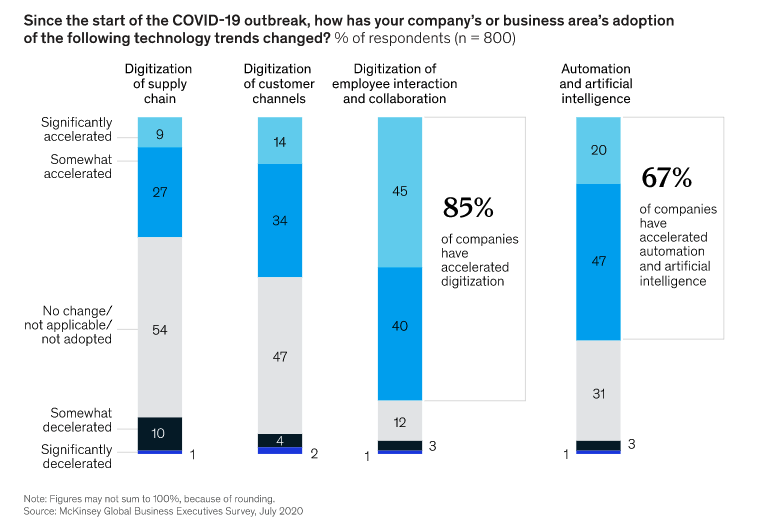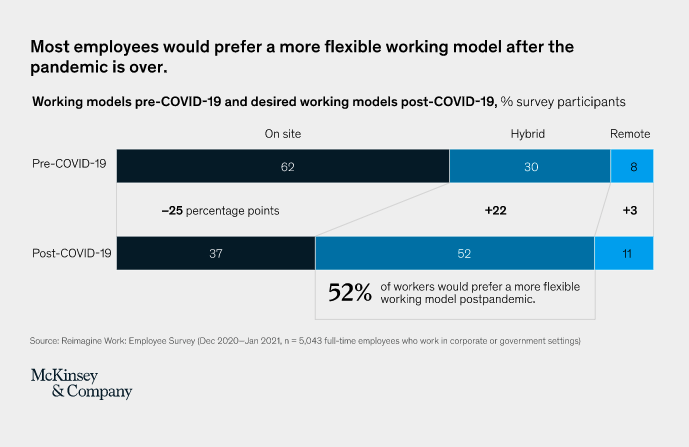How to Conduct a SWOT Analysis For Digital Transformation


Many organizations have had some elements of digital transformation underway for years, but the pandemic accelerated the adoption of new technology like never before. The shift to more remote work revealed gaps in the tools employees use to communicate, collaborate, and respond to customers’ changing needs.
A recent McKinsey survey of 800 executives found 85% had accelerated the adoption of digital workplace tools for employee collaboration. If your organization is considering moving forward with digital workplace initiatives but you’re not sure how to prioritize them, it helps to look at where other companies are investing first. Then you can conduct a SWOT analysis for digital transformation to determine which needs are the most pressing.
What is a SWOT analysis for digital transformation?
A SWOT (which stands for strengths, weaknesses, opportunities, and threats) analysis is a strategic planning tool companies use when they are considering making a major change, such as pursuing new business models or undergoing a digital transformation. Conducting a SWOT analysis usually involves creating a two-by-two grid and then placing strengths and weaknesses in the first row and opportunities and threats in the bottom squares.
A SWOT analysis enables decision-makers to gain comprehensive insight into all factors that can affect the outcome of the proposed action. It also requires organizations to base decisions on data analytics, rather than hypotheses and assumptions. A SWOT analysis helps decision-makers evaluate their company from all angles and consider different perspectives.
How to conduct a technology SWOT analysis
Before you go down this path, it’s helpful to start with a good understanding of how other companies are adopting digital workplace technology. This graph from McKinsey shows which areas are getting the most attention. It’s interesting to note, for instance, that 67% of companies have accelerated automation and artificial intelligence in addition to collaboration tools.

And with more than half of employees saying they prefer a hybrid work environment where they can split their time between home and the office, desk booking software that allows people to reserve space when they need it is becoming a top priority.

More companies are also investing in touchless technology, such as sensor-enabled doors, lights, and faucets. Mobile apps are replacing touchscreens to help visitors and employees check in, find their way around buildings, and reserve rooms or make requests.
Think about which of these elements could improve your workplace experience by making it easier for employees to find what they need to be productive.
Of course, you also need to consider your existing technology as you decide how to move forward with digital transforamtion. A SWOT analysis for technology involves evaluating the four main areas in the context of your digital workplace and reflecting on your answers.
Strengths
Strengths are the positive attributes of your company that allow you to operate efficiently, generate revenue and achieve business goals. This includes tangible aspects, like well-managed facilities and the latest workplace technology, and intangible aspects, such as your reputation and the skills of your workforce. Strengths are anything that gives you a competitive advantage.
When it comes to digital transformation, where is your company performing exceptionally well? For instance:
- Our workplace technology has been updated within the past year
- We have a highly skilled and innovative IT team
Weaknesses
Weaknesses are the aspects of your company that hurt the perceived and actual value or prevent you from outperforming your competition. Examples of weaknesses hindering your digital transformation strategy include manual processes that could be automated, outdated workplace technology or difficulty managing your workplace data.
Weaknesses can also be assets, resources or attributes your company is missing. For instance:
- Employees have to navigate between too many different workplace apps throughout the day
- We don’t have an easy way to manage conference room scheduling
Opportunities
While strengths and weaknesses are considered internal factors, opportunities and threats are external elements that can influence the success of the change or initiative. Opportunities are factors your company can leverage to gain an advantage over competitors, such as market shifts, new cultural trends, changes to the industry or upcoming tech launches.
Within the context of a digital transformation, your greatest opportunities might be:
- Moving to cloud-based, software-as-a-service (SaaS) applications
- Consolidating multiple applications into one to simplify our technology stack
Threats
Threats include anything outside the organization that could negatively impact your ability to implement a digital transformation strategy. These are the elements that are out of your control. Examples of threats are new competitors entering the marketplace, service providers increasing prices, changes in the economy and new government regulations.
Examples might include:
- New data security regulations could impact our IT department
- A greater reliance on contractors in the gig economy will make it more difficult for us to predict our future office space needs
10 questions to guide your technology SWOT analysis
In the context of undertaking a digital transformation, here are 10 questions you can ask to help you determine where your company’s strengths and weaknesses lie:
- Is our company’s data remotely accessible to the appropriate individuals but also protected by user-level permissions?
- How flexible and scalable is our current IT infrastructure? (In other words, how easily can existing solutions be integrated with new platforms?)
- Are our core business systems hosted on premise or in the cloud?
- Do our processes and technological investments support the mobility and agility of the workforce?
- Is our company’s data secure from external and internal threats such as cybercrime and employee theft?
- Do employees appreciate the processes and technologies in the workplace or do they find them to be frustrating?
- How many different software platforms does the average employee have to use throughout the day?
- Do our primary software solutions communicate with each other?
- Does our existing technology stack enable data-driven decision-making?
- How easily can we update our workplace technology to meet our changing needs?
To identify opportunities and threats, you’ll need to conduct thorough, unbiased research about your organization, industry and market. It’s important to be honest when assessing your company’s current position and performance. Viewing your organization through rose-colored glasses will only hinder your digital transformation strategy. It’s also critical to be realistic about the possible impact of the factors you identify as threats. In other words, don’t underestimate or overestimate their potential effect.
Once you’ve decided your workplace is in need of a digital transformation, a SWOT analysis is an excellent way to guarantee you start on the right foot. Be sure your SWOT team consists of a variety of individuals across the organization, including mid-level employees as well as members of the executive team. More diverse knowledge and experience will help ensure you don’t overlook anything and increase your chance of success.
Need to upgrade your technology to meet today’s new standards for health and safety? See how our return-to-work solutions can help.
